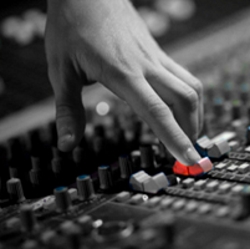
2) Reverb Addition/Differences
The more reverb effect you give to a sound, the more distant it will sound in the mix. Used in combination with volume differences, you can create a huge amount of perceived space in the mix.
Back to “Agnus Dei”—when the song ends with the repetitious phrase of “Worthy is the Lamb, you are Holy, you are Holy, are you Lord God almighty” there are three voices; Smitty’s voice, the choir, and a male vocal.
Smitty’s voice stops and you hear the choir (backing vocals) and a solo male voice. Both the choir and the male voice have a lot of reverb and even though that male voice sings a bit differently as far as his timing, he is sitting distantly in the mix. The two are different and distinct and distant.
You might have an acoustic guitar playing rhythm with the piano driving the song. You’d want the piano to be a little louder in the mix, but you could also add reverb to the guitar so it sounds like it’s farther back in the mix.
3) EQ Differences
The process of equalization is a normal part of separating out sounds from one another so they each have their proper place in a mix. I often use the analogy that mixing is like painting. Each sound is a color and you want a painting of a wide variety of colors.
But how can you use EQ to add depth?
Any time you reduce the presence of an instrument by cutting it’s primary frequencies, you are moving it back in the mix. Let’s look at the use of highs and lows for adding depth.
The more low-end from an instrument, the more forward it’s going to appear in the mix. Take the kick drum or the bass. Crank that low end and it’s in your face. Reduce it significantly, and the instrument is sitting way back in the mix.
The more high-end, the more forward in the mix such as with an acoustic guitar…but what if you add in reverb? And here is where you need to know about working through the different layers of depth.
What do you do if you want an acoustic guitar, playing a lead line, to stand out in the mix but feel like it’s just breaking through the other instruments?
Combining The Three
Take the example of that lead acoustic guitar I just mentioned. You can combine volume, reverb, and EQ to place the instrument exactly where you want it. You’d use the volume to place it in the right relationship with the other instruments for that particular song.
Then, you’d use reverb to further give it a unique depth placement and unique sound. Finally, you’d use EQ changes, such as boosts in the high-end range to give it the feeling of just breaking through into the mix so it stands out to carry the emotional feel you want.
The Take Away
One of the aspects of mixing is adding depth to a song. While the band can do a lot through instrument and vocal arrangement, you can do a lot of arranging by adding depth to the sounds. You can take the same song and produce several different versions based only on differing depths of the sounds.
The next time you’re mixing, pick one instrument and try moving it to different depths in your mix. Notice how much that depth adds or takes away from the quality of the mix.
Chris Huff is a long-time practitioner of church sound and writes at Behind The Mixer, covering topics ranging from audio fundamentals to dealing with musicians – and everything in between.
